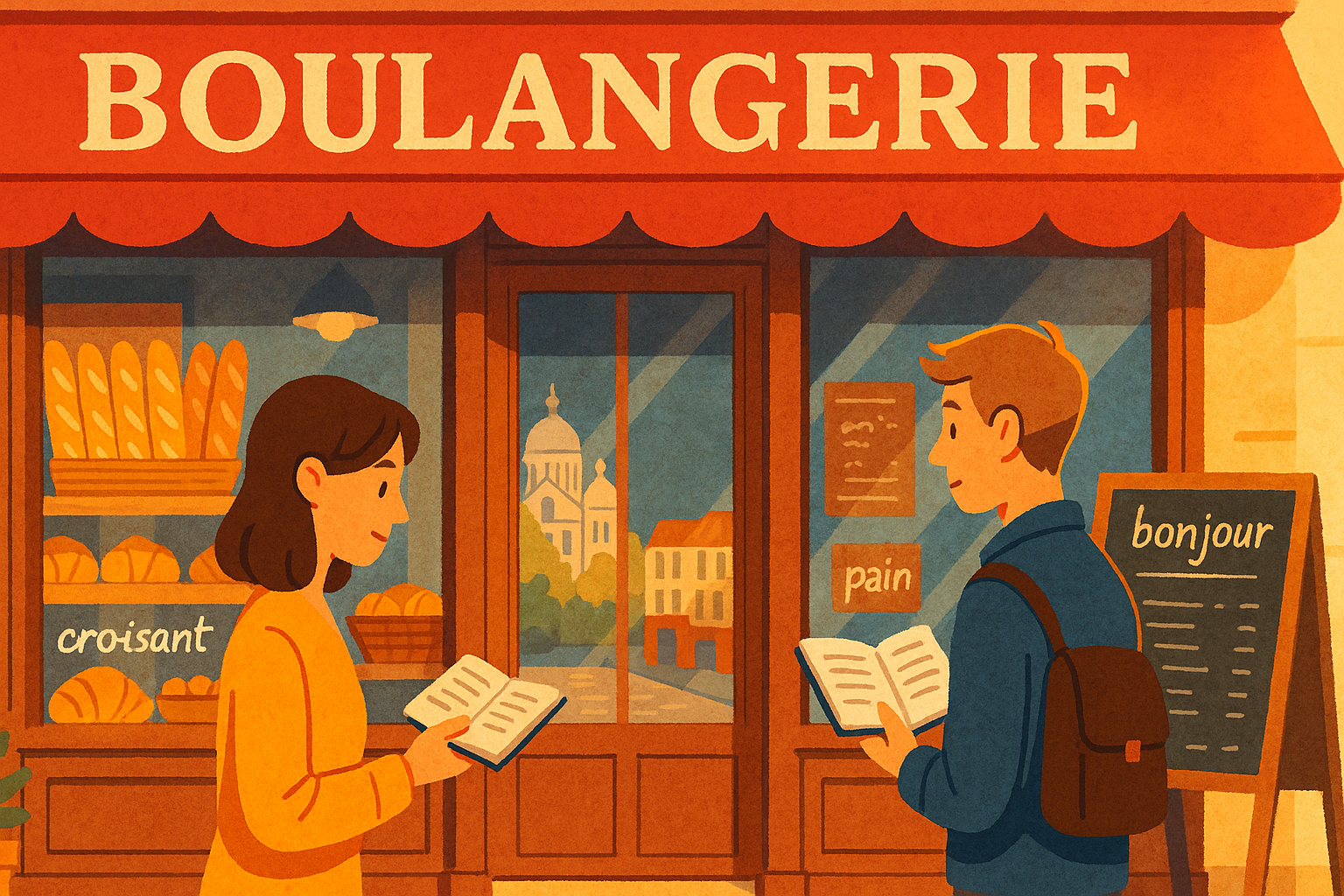French bakery culture (A1–B1) — etiquette, ordering, daily bread
French bakery culture is friendly and fast: greet, choose, pay, and leave with warm bread. This A1–B1 guide gives clear phrases with IPA and English, so you can ask for a crispy baguette, pick pastries, request slicing, and chat politely at the counter without stress.

Why French bakery culture matters
French bakeries represent more than retail spaces—they function as daily gathering points and cultural anchors in neighborhoods across France. The morning ritual of buying fresh bread connects residents to centuries-old traditions while supporting local artisans. Understanding bakery etiquette and vocabulary transforms a simple purchase into a meaningful cultural exchange. Most French households buy bread daily rather than weekly, prioritizing freshness over convenience. This practice sustains small businesses and maintains quality standards that define French gastronomy.
The baguette itself earned UNESCO Intangible Cultural Heritage status, recognizing its significance beyond nutrition. Bakers follow strict regulations regarding ingredients, fermentation times, and baking methods. A true baguette contains only flour, water, salt, and yeast, without preservatives or additives. This simplicity demands skill and attention to detail that separate exceptional bakeries from ordinary ones.
1) Greet and set the tone (A1)
Every bakery visit begins with a greeting. French service culture values politeness highly, and skipping this step marks you as unfamiliar with local customs. The greeting establishes mutual respect between customer and baker.
🇫🇷 FR — Bonjour, s’il vous plaît. /bɔ̃ʒuʁ sil vu plɛ/
🇺🇸 EN — Hello, please.
🇫🇷 FR — Je voudrais une baguette, merci. /ʒə vudʁɛ yn bagɛt mɛʁsi/
🇺🇸 EN — I would like a baguette, thank you.
Wait for acknowledgment before stating your order. Rushing or interrupting conversations between staff and other customers disrupts the flow and appears impatient. French bakeries operate efficiently but maintain a human pace that respects each interaction.
2) Understanding bread varieties (A1→A2)
French bakeries offer numerous bread types beyond the classic baguette. Each variety serves different purposes and occasions. Learning to distinguish them enhances your shopping experience and meal planning.
Classic baguette options
🇫🇷 FR — Une baguette bien cuite, s’il vous plaît. /bjɛ̃ kɥit/
🇺🇸 EN — A well-baked baguette, please.
🇫🇷 FR — Une tradition pas trop cuite. /tʁadisjɔ̃/
🇺🇸 EN — A “tradition” baguette, not too baked.
🇫🇷 FR — Une baguette normale. /nɔʁmal/
🇺🇸 EN — A regular baguette.
🇫🇷 FR — Une demi-baguette, s’il vous plaît. /dəmi bagɛt/
🇺🇸 EN — A half-baguette, please.
The “baguette tradition” uses traditional methods and specific flour types, resulting in deeper flavor and longer shelf life than standard baguettes. Expect to pay slightly more for this premium option. “Bien cuite” means darker, crispier crust—ideal for those who enjoy texture. “Pas trop cuite” delivers softer crust preferred by children and those making sandwiches.
Specialty breads
🇫🇷 FR — Un pain de campagne, s’il vous plaît. /pɛ̃ də kɑ̃paɲ/
🇺🇸 EN — A country loaf, please.
🇫🇷 FR — Avez-vous du pain complet ? /pɛ̃ kɔ̃plɛ/
🇺🇸 EN — Do you have wholemeal bread?
🇫🇷 FR — Un pain aux céréales. /pɛ̃ o seʁeal/
🇺🇸 EN — A multigrain bread.
🇫🇷 FR — Du pain de seigle, s’il vous plaît. /sɛɡl/
🇺🇸 EN — Rye bread, please.
Special requests
🇫🇷 FR — Vous pouvez la couper ? /kupe/
🇺🇸 EN — Can you slice it?
🇫🇷 FR — Avez-vous du pain sans gluten ? /sɑ̃ ɡlytɛn/
🇺🇸 EN — Do you have gluten-free bread?
🇫🇷 FR — Quelle est la différence entre ces deux pains ? /difeʁɑ̃s/
🇺🇸 EN — What’s the difference between these two breads?
Most bakeries willingly slice bread upon request, though traditional French meals serve bread whole for tearing at the table. Gluten-free options remain less common in traditional bakeries but appear increasingly in urban areas responding to dietary needs.
3) Ordering pastries like a local (A1→B1)
Viennoiseries—buttery breakfast pastries—represent French baking artistry. Quality varies dramatically between bakeries. Look for golden color, visible layers, and butter aroma indicating fresh, properly made products.
🇫🇷 FR — Un croissant, s’il vous plaît. /kʁwasɑ̃/
🇺🇸 EN — A croissant, please.
🇫🇷 FR — Un pain au chocolat. /pɛ̃ o ʃɔkɔla/
🇺🇸 EN — A chocolate croissant.
🇫🇷 FR — Un pain aux raisins. /pɛ̃ o ʁɛzɛ̃/
🇺🇸 EN — A raisin pastry.
🇫🇷 FR — Une brioche, s’il vous plaît. /bʁijɔʃ/
🇺🇸 EN — A brioche, please.
Asking about freshness and recommendations
🇫🇷 FR — C’est fait maison ? /fɛ mɛzɔ̃/
🇺🇸 EN — Is it homemade?
🇫🇷 FR — Qu’est-ce que vous conseillez aujourd’hui ? /kɛs kə vu kɔ̃seje oʒuʁdɥi/
🇺🇸 EN — What do you recommend today?
🇫🇷 FR — Ils sont frais du jour ? /fʁɛ dy ʒuʁ/
🇺🇸 EN — Are they fresh today?
🇫🇷 FR — Je prends aussi une tartelette au citron. /taʁtəlɛt o sitʁɔ̃/
🇺🇸 EN — I’ll also take a lemon tartlet.
Asking “C’est fait maison?” distinguishes bakeries that produce everything on-site from those purchasing frozen products. True artisan bakeries take pride in confirming their homemade status. Morning visits guarantee freshest selection, though many bakeries bake additional batches throughout the day.
4) Small talk and cultural customs (A2)
Brief, friendly exchanges characterize French bakery interactions. These moments build neighborhood relationships and demonstrate cultural integration. Compliments about products or brief comments about weather fit naturally into transactions.
🇫🇷 FR — Elle sent très bon, votre baguette ! /sɑ̃ tʁɛ bɔ̃/
🇺🇸 EN — Your baguette smells wonderful!
🇫🇷 FR — C’est pour le déjeuner. /sɛ puʁ lə deʒøne/
🇺🇸 EN — It’s for lunch.
🇫🇷 FR — Vous avez de nouveaux gâteaux ? /nuvo ɡato/
🇺🇸 EN — Do you have new cakes?
🇫🇷 FR — Merci, bonne journée ! /mɛʁsi bɔn ʒuʁne/
🇺🇸 EN — Thank you, have a nice day!
Regular customers develop rapport with bakers who remember preferences and offer recommendations. This relationship transforms routine errands into pleasant social moments that enrich daily life.
5) Payment and practical considerations (A1)
French bakeries increasingly accept cards, though some maintain cash-only policies for small purchases. Asking politely avoids awkwardness at checkout.
🇫🇷 FR — Je peux payer par carte ? /pɛje paʁ kaʁt/
🇺🇸 EN — Can I pay by card?
🇫🇷 FR — Vous avez la monnaie ? /mɔnɛ/
🇺🇸 EN — Do you have change?
🇫🇷 FR — Un sac en papier, s’il vous plaît. /sak ɑ̃ papje/
🇺🇸 EN — A paper bag, please.
🇫🇷 FR — Combien ça coûte ? /kɔ̃bjɛ̃ sa kut/
🇺🇸 EN — How much does it cost?
Planning your visit
🇫🇷 FR — Vous ouvrez à quelle heure demain ? /uvʁe a kɛl œʁ/
🇺🇸 EN — What time do you open tomorrow?
🇫🇷 FR — Vous êtes fermés quel jour ? /fɛʁme kɛl ʒuʁ/
🇺🇸 EN — Which day are you closed?
🇫🇷 FR — À quelle heure sortent les croissants ? /sɔʁt/
🇺🇸 EN — What time do the croissants come out?
Most French bakeries close one day weekly, typically Monday or Tuesday. Sunday morning represents peak shopping time when families purchase bread for leisurely brunches. Arriving early ensures best selection but expect crowds. Afternoon visits offer quieter experiences though fewer options remain.
6) Essential cultural knowledge (A1→B1)
Understanding freshness windows
Baguettes undergo multiple daily baking cycles. Morning batches serve breakfast shoppers, midday production targets lunch buyers, and late afternoon baking supplies dinner customers. This schedule ensures constant freshness that defines quality French bakeries. Asking when the next batch emerges demonstrates appreciation for freshness and helps you time purchases optimally.
Queue etiquette
French bakeries handle queues informally compared to Anglo-Saxon explicit lines. Customers track arrival order mentally and assert their turn when appropriate. Watch carefully to determine your position. Staff often ask “C’est à qui?” (Whose turn?) when unclear. Respond clearly if next, or gesture to others who arrived earlier.
Regional bread traditions
Different regions maintain distinct bread specialties. Paris favors long, thin baguettes while southern France prefers thicker, rounder loaves. Alsace offers pretzels and seed-crusted breads reflecting German influences. Exploring regional varieties reveals France’s diverse baking heritage and provides conversation topics with bakers.
The art of bread selection
Experienced customers assess bread quality through observation. Golden-brown color indicates proper baking temperatures. Visible flour dusting suggests hand-shaping rather than machine production. Irregular shapes signal artisan methods. The crust should crack gently when squeezed, demonstrating proper texture without excessive hardness.
7) Common mistakes to avoid
Anglophone visitors often commit predictable errors that mark them as unfamiliar with French bakery culture. Awareness prevents these missteps and smooths interactions.
Forgetting greetings. Always begin with “Bonjour” even when rushed. This simple courtesy matters enormously in French social interactions and skipping it appears rude regardless of intentions.
Touching products. Never select bread or pastries yourself unless invited. Point clearly to desired items and let staff handle them. This hygiene practice protects all customers and maintains professional boundaries.
Expecting American-style service. French bakery interactions prioritize efficiency over extended conversation. State your order clearly and concisely without elaborate explanations. Save longer discussions for quieter moments when other customers aren’t waiting.
Ignoring peak times. Avoid shopping during the 7:30-8:30 AM rush when workers grab breakfast, or the 12:00-12:30 PM lunch surge. These crowded periods create stress for everyone involved.
Pronunciation keys
- Nasal vowels: In pain /pɛ̃/ and bon /bɔ̃/, keep air flowing through the nose—don’t add a hard “n” sound afterward.
- French R: Produce light throat friction, brief and controlled, never rolled like Spanish R.
- Silent letters: Final consonants often stay silent in French. Practice croissant /kʁwasɑ̃/ without pronouncing the final “t.”
- Liaison: Listen for connected sounds like vous‿avez /vu.zave/ when staff speak quickly during busy periods.
Study glossary (FR → IPA → EN)
| FR | IPA | EN |
|---|---|---|
| Boulangerie | /bulɑ̃ʒʁi/ | Bakery |
| Baguette | /bagɛt/ | Baguette |
| Tradition | /tʁadisjɔ̃/ | Traditional baguette |
| Bien cuite | /bjɛ̃ kɥit/ | Well-baked |
| Pas trop cuite | /pa tʁo kɥit/ | Not too baked |
| Couper | /kupe/ | To slice |
| Viennoiserie | /vjɛnwaziʁi/ | Pastry (croissant, etc.) |
| Pain complet | /pɛ̃ kɔ̃plɛ/ | Wholemeal bread |
| Sans gluten | /sɑ̃ ɡlytɛn/ | Gluten-free |
| Monnaie | /mɔnɛ/ | Change (money) |
| Sac en papier | /sak ɑ̃ papje/ | Paper bag |
| Ouvrir | /uvʁiʁ/ | To open |
| Croissant | /kʁwasɑ̃/ | Croissant |
| Pain au chocolat | /pɛ̃ o ʃɔkɔla/ | Chocolate croissant |
Authoritative references
Explore cultural background and terminology:
Learn French with Roger, Native French Tutor
Expert instruction with proven teaching methods. Personalized lessons tailored to your goals from A0 to C1.
Weekly Lessons with Roger
Learn with Roger, a native French tutor. Structured curriculum from beginner to advanced.
- Native French speaker from France
- All levels (A0-C1) supported
- Personalized curriculum
- Proven teaching methodology
Trial Lesson with Roger
Experience Roger’s teaching method with a 25-minute trial session. Perfect to get started.
- 25 minutes with Roger
- Level assessment included
- Personalized learning roadmap
- No commitment required
A1 Foundations Guide
Complete beginner’s guide created by Roger. Structured lessons with native pronunciation.
- Step-by-step A1 curriculum
- Audio by native French speaker
- Practice exercises included
- Learn at your own pace
Continue Learning
Check out these related articles

French pharmacy phrases (A1–B1) — symptoms, advice, dosage, and OTC help
French pharmacy phrases help you explain symptoms, ask for over-the-counter help, and confirm dosage and side effects. This A1–B1 guide…

Best online dictionaries for French to English translation — beyond WordReference (A1–C1)
Discover the best online French-English dictionaries beyond WordReference, including specialized tools for context, pronunciation, technical vocabulary, and professional translation that…

French restaurant booking phrases (A0–A2) — reserve, arrive, order
french restaurant booking phrases help you secure a table, arrive smoothly, and start the meal with confidence. This A0–A2 guide…
👋 Join Our Community
Follow us for daily tips, pronunciation tricks, and free resources
👍 Follow on Facebook